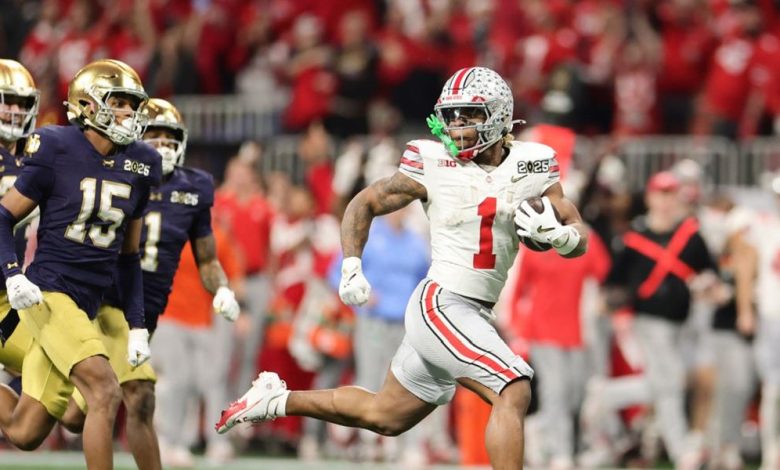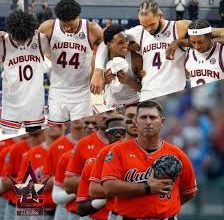As NIL turns collegiate athletics into a “pro-style” paradigm, the Ohio State Buckeyes want to win the championship again.

The landscape of collegiate athletics has undergone a dramatic transformation over the past few years, and at the heart of this evolution is the rise of NIL (Name, Image, and Likeness). The introduction of NIL rights has allowed college athletes to monetize their personal brand, leading to a “pro-style” environment in college sports. This paradigm shift has brought new opportunities for athletes but has also created a new set of challenges for collegiate programs striving for success. Among the programs trying to adapt and thrive in this new era is Ohio State University, a school with a rich football tradition and a deep desire to reclaim its place at the top of the college football world.
As one of the most storied programs in NCAA history, Ohio State football has long been a powerhouse. With multiple national championships, Big Ten titles, and a legacy of producing NFL talent, the Buckeyes are consistently one of the most competitive teams in the nation. However, the dynamics of college football have changed in recent years, and Ohio State finds itself facing new competition—not only on the field but also in the arena of recruiting, player retention, and financial investment.
NIL has fundamentally altered how colleges recruit, retain, and reward their athletes. As the NIL era continues to evolve, programs like Ohio State are looking for ways to leverage these new rules to their advantage. With head coach Ryan Day at the helm, the Buckeyes are focused on adapting to this new landscape while striving to win another national championship.
The Impact of NIL on College Football
The NCAA’s decision to allow athletes to profit from their name, image, and likeness marked a seismic shift in the world of college sports. Athletes are now allowed to sign endorsement deals, profit from social media, and make money from personal appearances. While NIL rights have provided significant financial opportunities for student-athletes, they have also introduced new complexities into the recruiting process. With schools no longer simply competing on the football field but also in the marketplace, the landscape has become more competitive than ever before.
For Ohio State, NIL presents both an opportunity and a challenge. On one hand, the Buckeyes’ large fan base, media presence, and marketability make them an attractive destination for athletes looking to capitalize on their personal brand. On the other hand, the wealth of opportunities available to top-tier recruits has led to an increase in player movement, as athletes are no longer bound by traditional college sports restrictions. Transfer portal activity, NIL incentives, and recruiting wars between schools have led to an environment where programs need to adapt quickly in order to stay competitive.
Ohio State’s Recruitment Strategy in the NIL Era
Ohio State football has always been a recruiting juggernaut, consistently landing top-tier talent from across the country. With a reputation for developing NFL-caliber players, a premier training facility, and a passionate fan base, the Buckeyes are an attractive destination for recruits. However, the introduction of NIL has leveled the playing field, allowing other schools—some with fewer traditional advantages—to lure high-profile recruits with lucrative endorsement deals.
In the NIL era, Ohio State has focused on using its brand and resources to create an environment where players can thrive both on and off the field. The school has worked to build partnerships with local businesses, national brands, and alumni to create opportunities for student-athletes to capitalize on their name, image, and likeness. Ohio State’s athletic department has also worked to educate athletes on the best ways to manage their NIL opportunities and maximize their earning potential.
The Buckeyes are also navigating the new recruiting landscape by expanding their efforts to target athletes who not only fit their football program’s needs but also have the potential to build a personal brand. Ohio State’s recruiting efforts are more holistic, taking into account factors like social media presence, marketability, and the ability to generate business deals. This is a departure from the past, where recruiting was focused almost entirely on on-field performance.
Ohio State’s extensive resources, including the support of its athletic department, coaches, and alumni network, give the program a significant advantage in this new NIL era. But despite these advantages, the Buckeyes must also contend with schools like Alabama, Georgia, and Texas A&M, who have deep pockets and aggressive NIL strategies of their own. The key to Ohio State’s success in the NIL era will be the ability to continue attracting top-tier talent while building an infrastructure that maximizes NIL opportunities for its athletes.
Building the Championship Culture Amidst Change
As Ohio State navigates the challenges of NIL, the program’s ultimate goal remains unchanged: winning national championships. Head coach Ryan Day, who took over for Urban Meyer in 2019, has established himself as one of the brightest minds in college football. Under Day’s leadership, Ohio State has consistently been a national contender, with multiple Big Ten championships and playoff appearances. But the program is hungry for more—a national championship that eluded the Buckeyes in the most recent seasons.
For Day and his coaching staff, the key to building a championship-caliber program in the NIL era is more than just assembling a roster of talented athletes. It’s about fostering a culture of commitment, discipline, and teamwork. Day has been vocal about the need to balance NIL opportunities with the core values of Ohio State football—hard work, unity, and a relentless drive to improve. In interviews, Day has emphasized the importance of building a cohesive locker room, where players are motivated by a collective desire to win rather than individual monetary incentives.
As the Buckeyes work to find the right balance between NIL and team culture, they are also looking to continue their tradition of developing players into NFL-caliber talent. Ohio State has long been a pipeline to the professional ranks, with numerous former players excelling in the NFL. The promise of NFL development remains a central selling point for Ohio State in recruiting top prospects, but NIL now plays an additional role in attracting recruits who may see the potential for significant financial opportunities during their college careers.
The Challenges of Retaining Talent in the NIL Era
While NIL has provided new opportunities for athletes, it has also introduced a new challenge for programs like Ohio State: retaining top talent. The rise of the transfer portal has made it easier for players to leave one school and join another, often with the promise of better NIL opportunities elsewhere. As a result, maintaining roster continuity and keeping star players happy with their NIL deals has become an ongoing challenge for coaches.
For Ohio State, retaining key players will require ongoing investment in NIL opportunities and resources. The Buckeyes will need to ensure that their athletes are satisfied with the deals they are able to secure while also keeping them focused on the team’s broader goals. This will require strong leadership from both coaches and administrators, who must navigate the complexities of NIL while ensuring that their athletes remain committed to the program’s mission.
In a sport as competitive as college football, where one or two key players can make the difference between a championship and a season of disappointment, Ohio State will need to work tirelessly to ensure that its stars remain in Columbus for the long haul. The program’s ability to adapt to this new landscape and keep its roster intact will play a significant role in its quest for another national title.
Ohio State’s Path to Championship Glory
As Ohio State looks ahead to the 2025 college football season, the goal remains clear: win the national championship. The Buckeyes have the talent, the coaching staff, and the resources to compete at the highest level, but the competition is fierce, and the dynamics of college football have changed.
To win the championship, Ohio State will need to continue recruiting at an elite level while maximizing the benefits of NIL. The team will need to develop its players both on and off the field, ensuring that athletes have the tools they need to succeed in a rapidly changing world of college sports. Ohio State’s success will also depend on maintaining team chemistry and focusing on the ultimate goal of winning, rather than getting caught up in individual NIL opportunities.
The 2025 season will likely see Ohio State face challenges both on the field and off, as the team juggles the realities of NIL with the drive for a national championship. However, with a strong tradition, a winning culture, and the leadership of Ryan Day, the Buckeyes are well-positioned to compete for the highest honor in college football once again. As Ohio State continues to adapt to the new NIL reality, one thing remains clear: the program’s pursuit of championship glory is as strong as ever.
In this new “pro-style” paradigm of college athletics, Ohio State will continue to evolve, and its pursuit of a national championship will serve as a testament to the resilience and determination of one of college football’s most successful programs.









